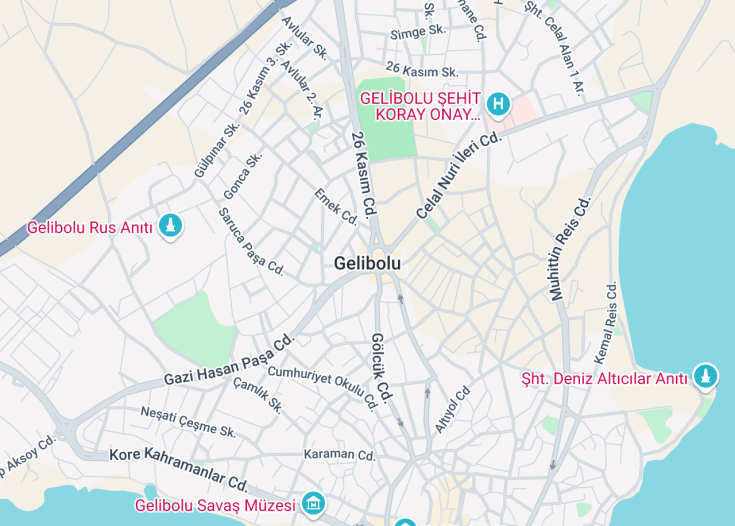Gelibolu, also known as Gallipoli, is a peninsula of profound historical significance located in northwestern Turkey. Known primarily for its role in World War I, particularly during the Gallipoli Campaign, it offers a deep dive into military history through well-preserved war cemeteries and memorials.
Beyond its poignant past, Gelibolu boasts stunning landscapes and clear waters, making it a unique blend of natural beauty and historical resonance. This destination appeals not only to history buffs but also to those seeking picturesque natural environments.
For an enriching experience, visit the Gallipoli peninsula during the quieter months of spring or fall when the weather is mild and the crowds are fewer.
Consider hiring a local guide when exploring historic sites in Gelibou. Their insights will greatly enhance your understanding of the area’s significant past and monuments.
Top things to do & see in Gelibou
Select the following sights and activities to discover best tickets and tours available in Gelibou.
Gelibou: A Hidden Gem at the Crossroads of History and Beauty
| Country | Turkey |
| Time in Gelibou | GMT+3 |
| Language spoken | Turkish |
| Population | 31,000 (source: Turkey Statistical Institute, 2023) |
| Currency | Turkish Lira (₺, TRY) |
| Airports |
|
Gelibou, a serene town in Turkey, possesses a rich tapestry of culture and history, often overlooked by mainstream tourism. Located on the historical Gallipoli Peninsula, Gelibou is not just a place on the map; it’s a narrative of time, featuring tales from ancient civilizations through the Byzantine Empire to the poignant events of World War I. The town is marked by its beautiful landscapes, framed by azure seas and green hills, making it a picturesque retreat.
Where is Gelibou?
Gelibou is situated on the southern coast of the Gallipoli Peninsula in Northwest Turkey, strategically lying along the Dardanelles Strait.
Distances:
| Route | Distance by car | Time by car |
|---|---|---|
| Istanbul to Gelibou | 200 miles / 322 km | Approx. 5 hours |
| Izmir to Gelibou | 350 miles / 563 km | Approx. 7 hours |
| Ankara to Gelibou | 450 miles / 724 km | Approx. 8 hours |
What is Gelibou famous for?
Gelibou is renowned for its historical significance, predominately for being the site of the Gallipoli Campaign during World War I. The town is a focal point for remembrance and studying the profound impacts of warfare on culture and international relations.
History
Prehistoric and Ancient Times
Gelibolu, historically known as Gallipoli, has been inhabited since prehistoric times, given its strategic position at the entrance of the Dardanelles Strait in Turkey. Archaeological evidence suggests early settlements date back to the Bronze Age, with significant influence from various ancient civilizations, including the Thracians. Over the centuries, control of Gelibolu switched hands among diverse powers, notably playing a role during the Trojan War era.
Byzantine and Ottoman Era (4th century – 1923)
In the Byzantine period, Gelibolu became a focal shipping and military hub due to its crucial maritime position. The fall of Constantinople in 1453 led to a long Ottoman rule. During the Ottoman period, Gelibolu gained further prominence as a shipyard and a key military outpost, helping to control the naval passage from the Mediterranean to the Black Sea. It played several strategic roles, especially highlighted during the famous naval battles and as a passage during the Crusades.
Modern Times: 20th Century to Present
The most poignant chapter in the history of Gelibolu is undoubtedly its role in World War I during the Gallipoli Campaign in 1915. The fierce battles between the Ottoman Empire and the Allied Forces, mainly comprising Australian, British, and New Zealand troops, left a lasting legacy and deep scars. The peninsula is now home to numerous war memorials and cemeteries honoring those who perished. In modern times, Gelibolu has developed as a modest town, focusing on fishing, agriculture, and increasingly on tourism, drawing visitors to its historic battlefields and beautiful natural settings.
Visit Gelibou
What to see and do in Gelibou, Turkey
Gelibou, a town steeped in history and natural beauty, offers an array of attractions for visitors.
The Gallipoli Peninsula Historical National Park, encompassing battlefields, war cemeteries, and memorials, stands as a poignant reminder of the impact of World War I.
Nature enthusiasts will appreciate the serene beaches and the unique flora and fauna of the region.
- Explore the Gallipoli battlefields and pay respects at ANZAC Cove.
- Visit the Gelibolu Mevlevi Museum for insight into Sufi culture.
- Stroll through the charming streets of the town center.
Annual Events in Gelibou
Gelibou hosts several events that reflect its rich history and cultural heritage. Notably, each year on April 25th, the Anzac Day Commemoration takes place, gathering thousands of visitors, especially from Australia and New Zealand, who come to honor their ancestors.
Additionally, throughout the summer, various cultural festivals showcasing music, dance, and local traditions enliven the town.
Best time to visit Gelibou
The best time to visit Gelibou is during the spring and early summer months, from April to June.
During this period, the weather is mild, and the Anzac Day commemoration adds a special historical significance to a visit. Early autumn is also pleasant, offering cooler temperatures and fewer tourists.
Is Gelibou worth visiting?
Gelibou is undoubtedly worth visiting for those intrigued by history, culture, and natural beauty. The area serves not only as a site of profound historical importance due to the World War I battles but also as a locale of breathtaking natural landscapes and genuine hospitality.
It offers meaningful experiences through its historical tours, poignant memorials, and vibrant local life, making it a compelling destination for a diverse range of tourists.










